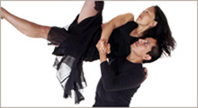West Wave Winds Down
Program 8
West Wave Dance Festival
Project Artaud Theater
San Francisco, California
July 30, 2006
by Ann Murphy
copyright ©2006 by Ann Murphy
 The last evening of the 2006 West Wave Dance Festival
was the odd duck of the festival’s final four
programs. Sunday nights often have a dreary
energy — everyone’s getting ready for another week in
the trenches, audiences are often sparse, and the mood
overall can seem dour. That was last Sunday. The light
in the theater even looked dimmer than usual, and
during intermission the crepuscular glow was so faint
the program text was illegible. The first night of the
week is a lousy time to end a festival, especially if
the planners want to finish with a bang. Go out on a
Saturday with a full house and a great after-party.
The last evening of the 2006 West Wave Dance Festival
was the odd duck of the festival’s final four
programs. Sunday nights often have a dreary
energy — everyone’s getting ready for another week in
the trenches, audiences are often sparse, and the mood
overall can seem dour. That was last Sunday. The light
in the theater even looked dimmer than usual, and
during intermission the crepuscular glow was so faint
the program text was illegible. The first night of the
week is a lousy time to end a festival, especially if
the planners want to finish with a bang. Go out on a
Saturday with a full house and a great after-party.
But if the only problem had been the character of
Sunday evening, that wouldn’t have been so bad. The
real obstacle was the curatorial choices that were
made, which led to a hodgepodge of a program. In fact,
it was an evening that seemed as aimlessly planned as
a low-tech, grassroots series of single dance acts. The compositional arrrangements were the all too
obvious ones — tying the four duets together, framing
the program with ensemble work — and rather than giving
the individual works support, or adding dimension
through juxtaposition, they undermined the dances.
They also left me scratching my head. Viktor
Kabaniaev’s “Duet,” which opened the second half, was
so austerely vivid, for instance, that Jose Navarrete
and Debby Kajiyama’s rendition of “Alonesome and
Twosome” (one of Remy Charlip’s airmail dances) was
left to dance in “Duet’s” dust. That meant that Jane
Schnorrenberg and Megan Marling’s lyrically eccentric “Squirrel,” which folllowed the Charlip, had to
navigate the the off-kilter atmosphere. “Squirrel”
came off looking inbred to my colleague; to me it just
seemed unfairly handicapped.
The curators had far better options. If Navarrete and
Kajiyama performed their dreamy interpretation of
“Alonesome” before they launched into their two
fiercely elegant tangos, it would have heightened the
audience’s grasp of both modern dance and the tango
form. “Squirrel,” which shares some of Randee
Paufve’s dance language but not her extreme emotional
climate, would have had a far more interesting life
next to Paufve’s “Burn.” Lisa Townsend’s wacky
vignettes, entitled “the short straw,” could have
followed “Squirrel” with aplomb. As it was, Townsend’s
light-hearted and clever study of relationship
triangles danced to Patsy Cline’s songs felt callow
stuck between Paufve’s infernal “Burn” and the tango
“Escualo.” There was no aesthetic reason to subject it
to an arrangement that dragged it down.
Among the performers, Tina Kay Bohnstedt, Jose
Navarette, Lisa Townsend, Kegan Marling, Randee Paufve
and Jane Schnorrenberg moved with preternatural
intensity, while virtually everyone on program 8
performed with commitment. Bohnstedt, whose sinewy
body is lithe yet strong, injected “Duet” with an
emotional cool that allowed the movement to speak
volubly. There was a nuanced softness to the demanding
entanglements between her and Ethan White that evoked
Alonzo King’s work, and Kabaniev proved that he can
employ abstraction not just as a pyrotechnical display
but as a means to reflect nonverbal truths between a
couple. Kegan Marling, despite a psoas spasm that
night, displayed an elfin elegance that is reminiscent
of Tere O’Connor’s style of dancing, and Schnorrenberg
made air seem like a beautifully viscous medium.
Navarette performed the tangos with an aptly masked
face that drove the eye to his leg work in order to
see what really was being discussed. Townsend's
combination of wit and suppleness made her a delight
to watch. And Paufve, whose movement suits her to a
tee, danced at the edge of the abyss, as always.
That the night was out of sorts, not the dancers or the dance, was underscored by the evening’s accidental coda. Joan Lazarus took the stage after the applause died and invited the audience to stay in its seats — a surprise was afoot and a dancer was going to be honored — someone who was supposed to have been feted before the show, except he didn’t arrive in time. The dancer was Brian Fisher, one of ODC’s all-time stellar dancers, and a company member for 14 years, who recently retired. Lazarus ceded the stage to ODC co-artistic director KT Nelson, and before long fellow dancers, both in person and by phone, arrived to sing his much-deserved praises. It was moving and heartfelt, and yet as people ached to leave their seats or marched down the aisles, it was also something of an afterthought. Like the night's dances it, too, was potent on its own terms and out of place in the evening's scheme.
Photos (courtesy of West Wave Dance Festival):
Jean Larock, Linda Bair, Katie Speck, Cathy Dean of the Linda Bair Dance Company. Photo: Matthias Falk.
Kate Weare. Photographer unknown.
Volume 4, No. 30
August 7, 2006
copyright ©2006 Ann Murphy
www.danceviewtimes.com